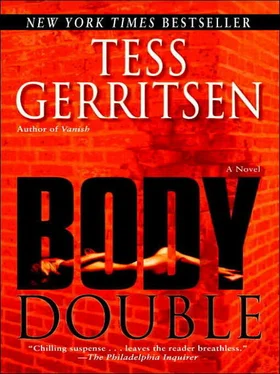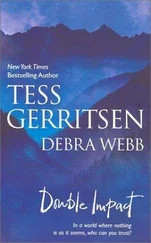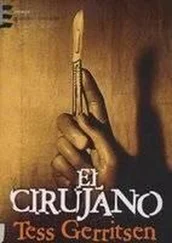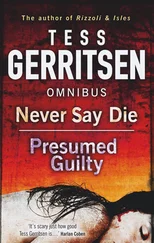“Anna Leoni’s murder may be tied in.”
“How?”
“Just before she was murdered, Anna was asking a lot of questions about Amalthea. Maybe she learned too much.” Rizzoli slid another file to O’Donnell.
“What’s this?”
“You’re familiar with the FBI’s National Crime Information Center? It maintains a searchable database of missing persons from across the country.”
“Yes, I’m aware of NCIC.”
“We submitted a search request using the key words female and pregnant. That’s what we got back from the FBI. Every case they have in their database, back to the 1960s. Every pregnant woman who’s vanished in the continental U.S.”
“Why did you specify pregnant women?”
“Because Nikki Wells was nine months pregnant. Karen Sadler was eight months pregnant. Don’t you find that awfully coincidental?”
O’Donnell opened the folder and confronted pages of computer printouts. She looked up in surprise. “There are dozens of names in here.”
“Consider the fact that thousands of people go missing every year in this country. If a pregnant woman vanishes every so often, it’s only a blip against that bigger background; it won’t raise any red flags. But when one woman a month vanishes, over a forty-year span, then the total numbers start to add up.”
“Can you link any of these missing persons cases to Amalthea Lank or her cousin?”
“That’s why we called you. You’ve had over a dozen sessions with her. Is there anything she’s told you about her travels? Where she’s lived, where she’s worked?”
O’Donnell closed the folder. “You’re asking me to breach patient-doctor confidentiality. Why would I?”
“Because the killing isn’t over. It hasn’t stopped.”
“My patient can’t kill anyone. She’s in prison.”
“Her partner isn’t.” Rizzoli leaned forward, closer to the woman she so thoroughly despised. But she needed O’Donnell now, and she managed to quell her revulsion. “The Beast fascinates you, doesn’t he? You want to know more about him. You want to get inside his head, know what makes him tick. You like hearing all the details. That’s why you should help us. So you can add one more monster to your collection.”
“What if we’re both wrong? Maybe the Beast is just a figment of our imaginations.”
Rizzoli looked at Frost. “Why don’t you turn on that overhead projector?”
Frost rolled the projector into position and flipped on the power switch. In this age of computers and PowerPoint slide shows, an overhead projector felt like Stone Age technology. But she and Frost had opted for the quickest, most straightforward way to make their case. Frost now opened a folder and took out multiple transparencies on which they’d recorded data points in various colors of marker ink.
Frost slid a sheet onto the overhead projector. A map of the U.S. appeared on the screen. Now he overlaid the map with the first transparency. Six black dots were added to the image.
“What do the dots signify?” O’Donnell asked.
“Those are NCIC case reports from the first six months of 1984,” said Frost. “We chose that year because it’s the first full year the FBI’s computerized database went active. So the data should be pretty complete. Each one of those dots represents a report of a missing pregnant woman.” He aimed a laser pointer at the screen. “There’s a certain amount of geographical scatter there, one case up there in Oregon, one in Atlanta. But notice this little cluster down here in the southwest.” Frost circled the relevant corner of the map. “One woman missing in Arizona, one in New Mexico. Two in Southern California.”
“What am I supposed to make of that?”
“Well, let’s take a look at the next six-month period. July through December, 1984. Maybe it’ll become clearer.”
Frost laid the next transparency over the map. A new set of dots was added, these marked in red.
“Again,” he said, “You’ll see some scatter around the country. But notice we have another cluster.” He sketched a circle around a group of three red dots. “San Jose, Sacramento, and Eugene, Oregon.”
O’Donnell said, softly: “This is getting interesting.”
“Wait until you see the next six months,” said Rizzoli.
With the third transparency, yet another set of dots was added, these in green. By now the pattern was unmistakable. A pattern that O’Donnell stared at with disbelieving eyes.
“My god,” she said. “The cluster keeps moving.”
Rizzoli nodded. Grimly she faced the screen. “From Oregon, it heads northeast. During the next six months, two pregnant women vanish from Washington state, then a third one disappears one state over, in Montana.” She turned and looked at O’Donnell. “It doesn’t stop there.”
O’Donnell rocked forward in her chair, her face alert as a cat about to pounce. “Where does the cluster move next?”
Rizzoli looked at the map. “Through that summer and fall, it moves straight east to Illinois and Michigan, New York and Massachusetts. Then it makes an abrupt drop to the south.”
“Which month?”
Rizzoli glanced at Frost, who shuffled through the printouts. “The next case shows up in Virginia, on December fourteenth,” he said.
O’Donnell said, “It’s moving with the weather.”
Rizzoli looked at her. “What?”
“The weather. See how it moved across the upper Midwest during the summer months? By fall, it’s in New England. And then, in December, it suddenly goes south. Just as the weather turns cold.”
Rizzoli frowned at the map. Jesus, she thought. The woman’s right. Why didn’t we see that?
“What happens next?” asked O’Donnell.
“It makes a complete circle,” said Frost. “Moves across the south, Florida to Texas. Eventually heads back to Arizona.”
O’Donnell rose from her chair and crossed to the screen. She stood there for a moment, studying the map. “What was the time cycle again? How long did it take to complete that circuit?”
“That time, it took three and a half years to circle the country,” said Rizzoli.
“A leisurely pace.”
“Yeah. But notice how it never stays in one state for long, never harvests too many victims in a single area. It just keeps moving, so the authorities never see the pattern, never realize it’s been going on for years and years.”
“What?” O’Donnell turned. “The cycle repeats?”
Rizzoli nodded. “It starts all over again, retracing the same route. The way old nomadic tribes used to follow the buffalo herds.”
“Authorities never noticed the pattern?”
“Because these hunters never stop moving. Different states, different jurisdictions. A few months in one region and then they’re gone. Onto the next hunting ground. Places they return to again and again.”
“Familiar territory.”
“ Where we go depends upon where we know. And where we know depends upon where we go, ” Rizzoli said, quoting one of the principles of geographic criminal profiling.
“Have any bodies turned up?”
“None of these have. These are the cases that remain open.”
“So they must have burial caches. Places to conceal victims, dispose of bodies.”
“We’re assuming they’d be out-of-the-way places,” said Frost. “Rural areas, or bodies of water. Since none of these women have been found.”
“But they found Nikki and Theresa Wells,” said O’Donnell. “Those bodies weren’t buried, but burned.”
“The sisters were found November twenty-fifth. We went back and checked the weather records. There was an unexpected snowstorm that week-eighteen inches fell in a single day. It took Massachusetts by surprise, closing down a number of roads. Maybe they couldn’t get to their usual burial spot.”
Читать дальше












